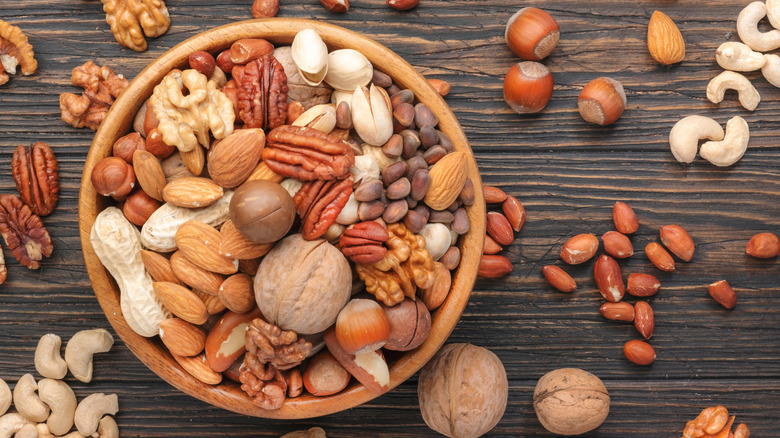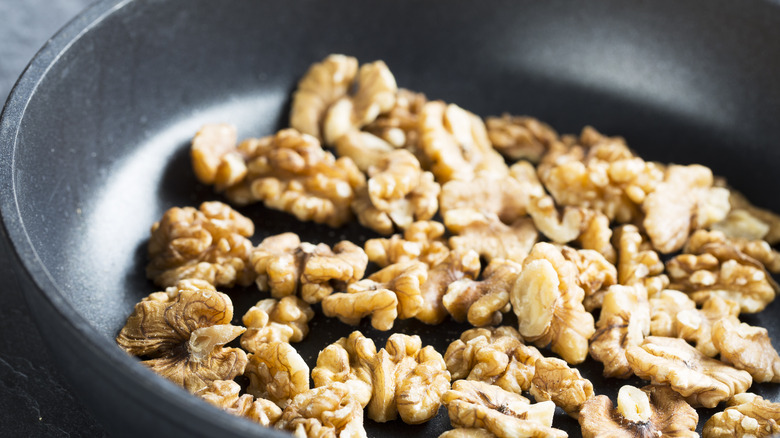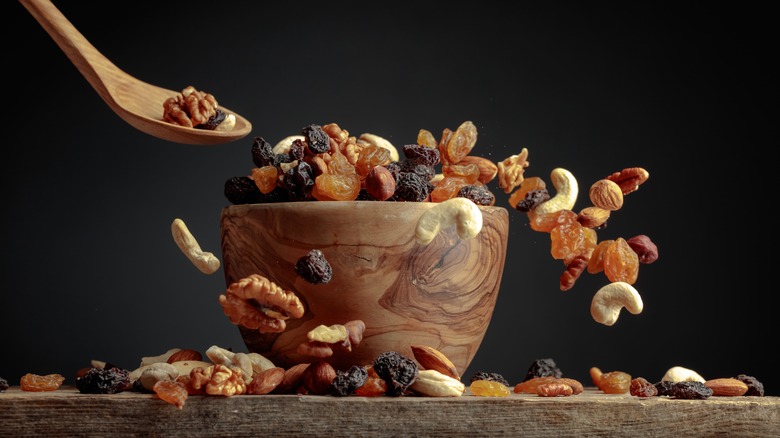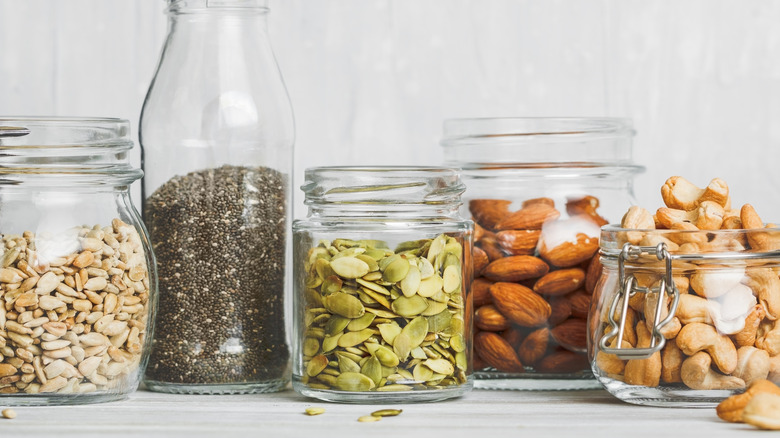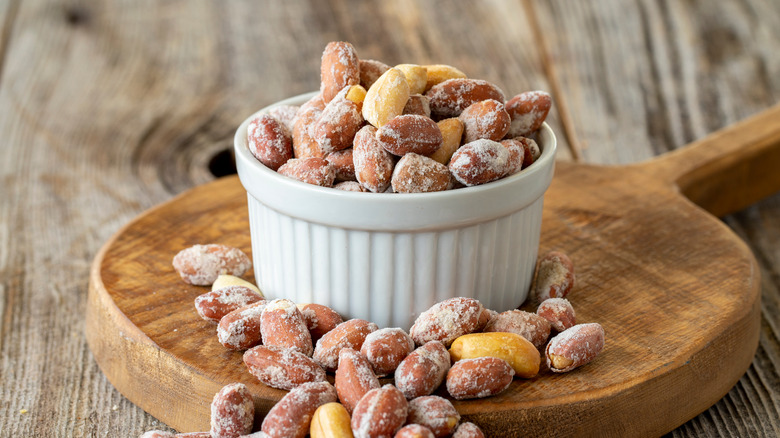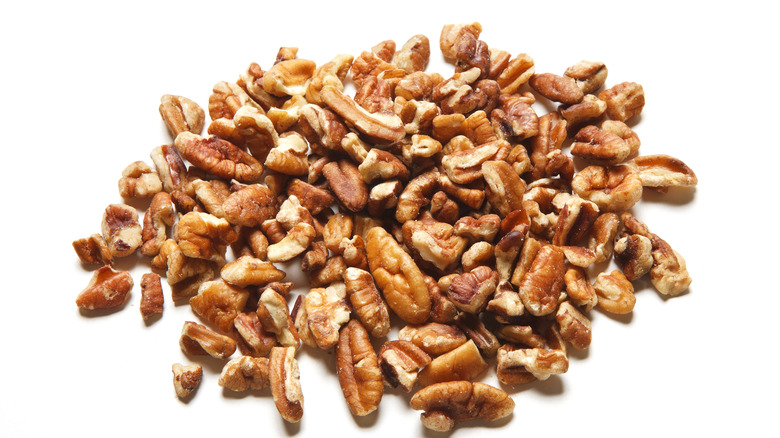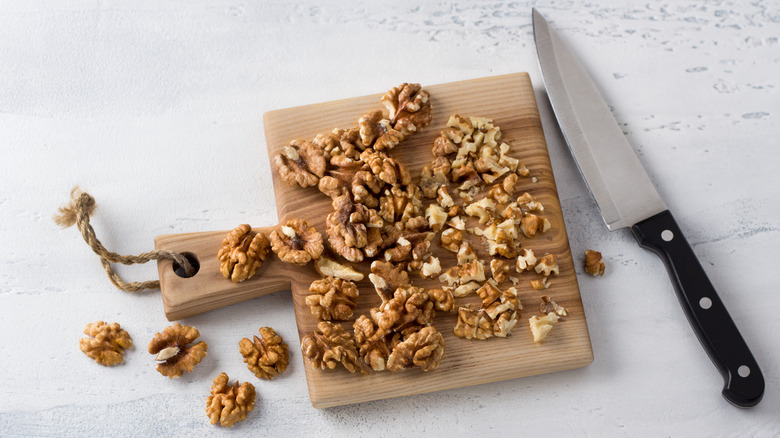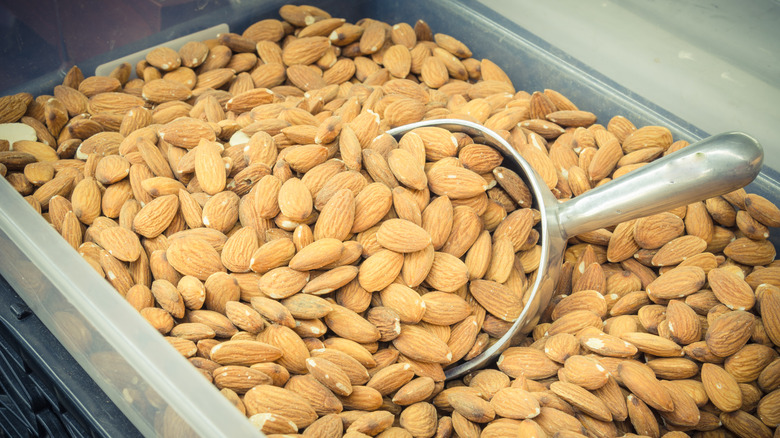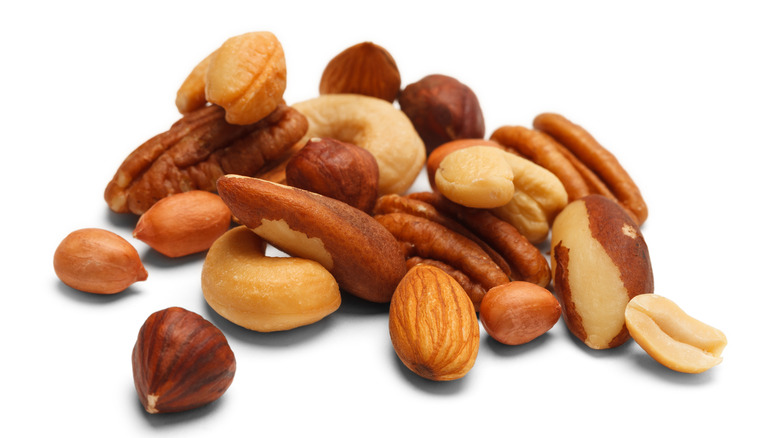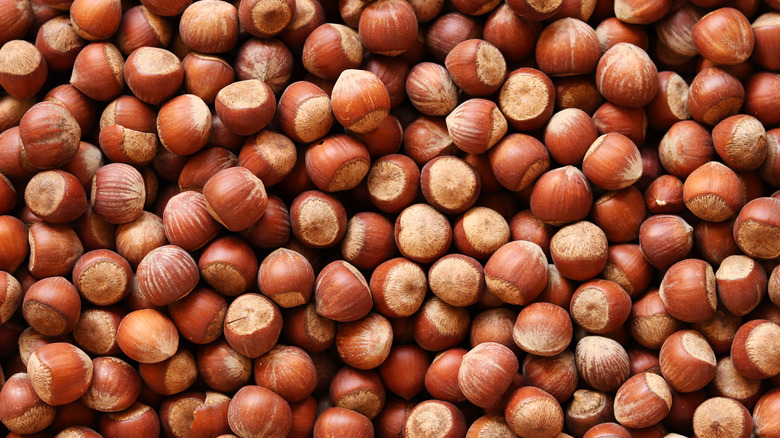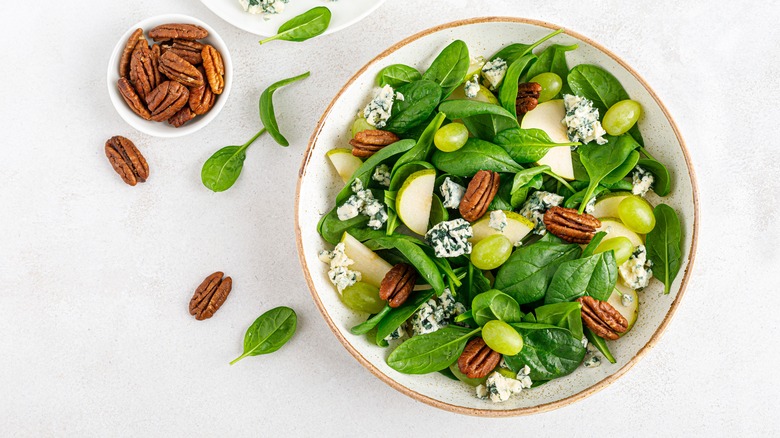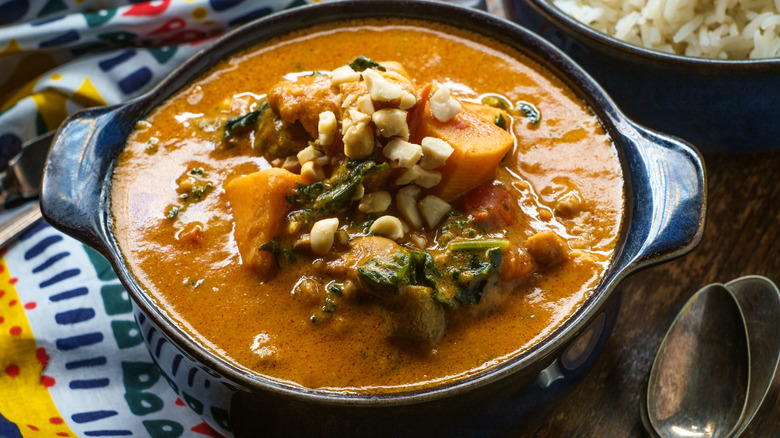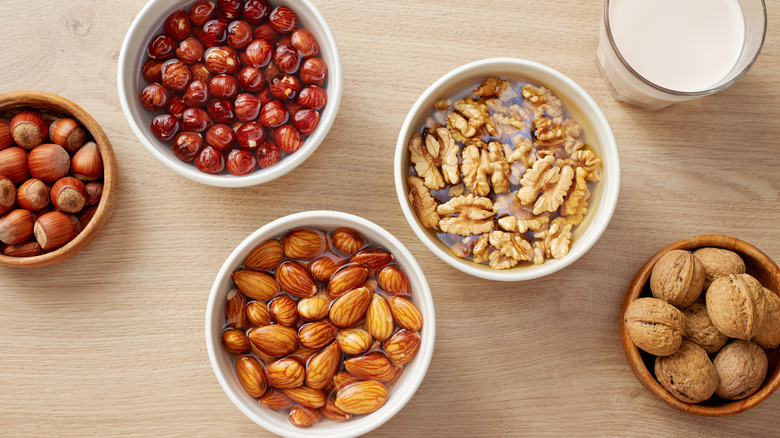Mistakes Everyone Makes When Cooking With Nuts
Unless someone in your household has an allergy to nuts, these nutritional powerhouses should be a staple in your kitchen. Additionally, they can play far more roles than you might think. Sure, they're great as snacks and crunchy accents to homemade cookies, quick breads, and granola, but if this is all you're using them for, you're missing out. Used properly, nuts can enhance — or even play a starring role in — everything from soup to salads to main dishes. As a bonus, they're also a great source of protein and other nutrients, which is surely useful to know if you're a vegetarian or just trying to reduce your meat consumption.
And if you've heard nuts are fatty and therefore unhealthy, you can relax. "Nutritional science has evolved to illuminate the differences in types of fats and their importance to our health," explained Emilie Berner, lead chef of online plant-based culinary arts and food operations at the Institute of Culinary Education. "[Nuts] are loaded with vitamin E, magnesium, folic acid, protein, and fiber. It is of course important to exercise portion management when eating nuts and to appreciate them as a concentrated form of energy." So now that we've convinced you to incorporate more nuts into your cooking, here are some tips for doing it right and how to avoid some common mistakes.
Not toasting nuts
When cooking with nuts, it's common for cooks to just toss a handful of them into whatever they're making. This is easy to do and the results will certainly be edible, but to take your nut game to the next level, consider a simple additional step: Toasting your nuts first. This not only adds additional crunch — a great feature if you're putting nuts in a salad or baked goods — but also enhances their flavor by releasing aromatic oils and causing them to caramelize. This will make a difference even if you're putting your nuts in something that will undergo further cooking (like mixing them into a banana bread batter).
You can toast nuts in several different ways, such as dry-roasting them in a frying pan on the stove. If you're going that route, be sure to use a heavy pan and stir frequently to prevent burning. You can also bake them in the oven, again stirring frequently to ensure even toasting, since ovens tend to have hot and cold spots. You might even zap them in the microwave, where, yes, you should stir often and keep an eye out for overcooking. If you're not pressed for time and want a completely hands-off process, you can also toast your nuts — albeit very slowly — in a bread machine.
Toasting nuts too long
In most preparations, toasted nuts are both more visually attractive and better tasting than raw nuts. But it's possible to have too much of a good thing. Toasting nuts for too long will make them bitter or even worse, burn them.
It's important to keep in mind the fact that toasting nuts isn't like toasting marshmallows. That's because most will be toasted sooner than you think, just after they've started to color. Deeply browned nuts are likely overcooked. In addition, some nuts (such as almonds) don't change much in color or appearance when properly toasted. So, trust your nose more than your eyes to determine when they're ready. Once you start to smell them, they're close to done.
While the bittering effects of over-toasting can't be reversed, they can be prevented by keeping a close watch on the nuts as you toast them. Stir them frequently to ensure they all toast at an even rate, and remove them from the heat the instant they start to look and smell done. Finally, transfer the nuts to a room-temperature plate or container, as this will prevent them from overcooking in the residual heat of the cooking pan or baking sheet.
Storing nuts incorrectly
A key to great-tasting dishes with nuts is starting with fresh ingredients. But all too often, cooks reach for that container of nuts they've been storing in the pantry, add it to their recipe, and find too late that the dish has been ruined by rancid nuts.
Many believe that nuts can be stored the same way as nonperishables like dried beans, rice, or pasta. In reality, nuts are far more fragile. Their high fat content makes them vulnerable to spoilage, meaning they should be handled more like fresh produce than sturdy pantry staples. "The fats in nuts are sensitive, so exposing them to light and heat begins to break them down and eventually they become rancid," Berner told Mashed. "Keep them in a cool, dark place. I store them in the refrigerator in airtight containers because I live in a warm climate." Other sources recommend keeping nuts in the freezer for long-term storage, though be thorough when wrapping them to avoid picking up freezer burn or other off-tastes.
Cooking with salted nuts
An important part of the success of any recipe is getting the salt levels right. Because tastes vary, this means you should not only follow the recipe's directions but taste as you go to ensure you get exactly the flavor you want. Furthermore, many common cooking ingredients such as capers, stock, olives, shellfish, and mustard are already salty. If you're using one or more of these, there's a possibility your dish will taste fine without any added salt.
By this token, a dish containing a lot of pre-salted ingredients could end up over-seasoned. Thus, to keep your flavors under control, keep a close eye on what goes into your pot. If you're cooking with nuts, think twice before tossing in those salted cocktail nuts you've been snacking on all week. "Salted nuts can completely disrupt the balance of a dish, so it's best to buy nuts that are raw and unsalted and then roast and season them yourself," Berner advised. "Be sure to check the packages first when purchasing nuts."
Buying chopped nuts
A lot of recipes, particularly for cookies, pastries, and other small baked goods, call for chopped nuts. When shopping for ingredients, many cooks reach for the closest bag of pre-chopped nuts. Manufacturers are no doubt ready to attract busy cooks who want to skip an extra step in the kitchen, meaning chopped nuts are easy to find in any grocery store.
But while this is super convenient and will probably yield edible results, it might not be the best move if you're making a recipe where nuts are going to be front and center. This is because nuts release their oils when cut, exposing them to oxygen. This exposure enables these oils to degrade more quickly, so pre-chopped nuts are more vulnerable to spoilage.
"Nuts should be purchased intact," Berner said. "Nuts that have been chopped up or crunched in some way are more likely to be rancid." So if you want the taste of your nuts to shine, take a few extra minutes and chop them yourself.
Not cooling toasted nuts
If you want the nuts in your finished dish to be crunchy and flavorful, you want them to be properly toasted. And if you're a perfectionist who cares about flavor, Berner advises that you buy raw nuts and toast (or roast) them yourself. "Sometimes it's a good shortcut to buy unsalted, roasted nuts, but beware: roasted nuts can go rancid faster than raw nuts because they have been manipulated with heat, so the flavor can be impacted," she said.
If you choose to go the extra mile and toast your own nuts, make sure you budget enough time to not only cook the nuts properly but to cool them down, especially if you're planning on chopping or grinding them. "Make sure they have cooled completely after toasting before pureeing or food processing them or they get gummy," Berner said.
If your end goal is chopped, roasted nuts, roast whole nuts, then chop them. By contrast, the pieces of chopped raw nuts will inevitably be of different sizes and won't roast evenly.
Not inspecting nuts before buying or cooking
Those of us in the developed world are lucky to generally have easy access to safe food. While the occasional recall or food poisoning outbreak does occur, most times we can go into virtually any grocery store and assume that whatever we grab off the shelves will be safe to eat.
Still, foods can be safe to eat without being very appetizing. For instance, savvy shoppers know to avoid bringing home wilted, bruised, or overripe produce or overly lean (or fatty) meat. If you're shopping for nuts, you should exercise the same due diligence.
Contrary to popular belief, nuts sold in bulk bins aren't always fresher than packaged ones. That's because they're repeatedly moved around and exposed to open air as shoppers open and close the bins, and thus may spoil more quickly. In addition, while package expiration dates are helpful, they aren't a guarantee of freshness. If a package has spent a lot of time exposed to light or heat, the nuts inside may not be at their best. So if you buy nuts from a bin, give them a good sniff before committing. Likewise, be sure to taste packaged nuts before using them in a recipe.
Using all nuts interchangeably
One of the biggest mistakes cooks can make when using nuts is thinking they're all alike. While we've all used the term "nutty" as a generic term for rich, toasty-tasting (or smelling) things, in reality, different nuts can vary greatly in taste, aroma, texture, and how they cook. While it's often fine to switch out one kind of nut for another, switching two completely different types can lead to disaster — or at least to a very different dish from what you intended. "I wouldn't swap a pistachio for a peanut in a peanut dipping sauce, but I could swap a pistachio for a pine nut in a pesto," Berner said.
So how can you know if it's okay to swap one nut for another? The best way, Berner said, is to familiarize yourself with a range of nuts and their unique flavors and textures. "Learning about the different nuts, their flavor profiles and how to use them comes with practice and trial and error," she said.
To get you started, plant-based chef, cookbook author, and culinary educator Matthew Kenney offers a few pointers on how certain nuts behave in recipes. "Hazelnuts pair well in a dessert dish, specifically with chocolate for a 'Nutella' effect," he told Mashed. "Toasted pine nuts will enhance any risotto and add a buttery, luxurious element to any dish. Macadamias are high in fat, so they do well in dishes with otherwise bitter ingredients to even things out."
Leaving the skin on hazelnuts
When cooking with nuts, it's important to know that some varieties require a bit more effort and special care than others. If you've ever had to shell whole walnuts, for example, you know how much work (and luck) is needed to get one out in a single piece. And while the fine, papery skin on freshly shelled peanuts is fine if you're snacking on them, you don't want it in your baked goods or cooked dishes. This is why most shelled peanuts come with their skins conveniently removed.
Hazelnuts are another nut with a conspicuous skin, but unlike peanuts, they're generally sold with the skin still attached. Because of this, many cooks assume the skin is fine to eat and so toss the nuts, skin and all, into whatever dish they're making. However, while this skin is perfectly safe to consume, it does not make for pleasant eating. "Hazelnut skins are bitter, so it's best to remove the skins but that can be tedious," Berner said.
She recommends two possible methods for removing the skin: rubbing it off the roasted hazelnuts with a clean towel, or putting the roasted nuts in a large bowl, topping it with a bowl of the same size, and shaking vigorously until the skins separate from the nuts. "It will be very loud, but possibly cathartic and effective for removing skins," she said.
Forgetting to counterbalance the flavor of nuts
An important strategy when cooking with nuts is choosing recipes and flavorings that work with, and not against, the natural flavor of the nuts you're using. This means that you need to understand the type of nut you're working with and know that some varieties, like cashews, play better with a wide range of flavorings than others. "Cashews are extremely versatile," Kenney told Mashed. "Like almonds, they do develop a natural crunch when sprouted and subsequently dehydrated, but also lend the creamiest purée when making vegan nut cheeses, sauces, or creams, because the mild flavor acts as a blank canvas for whatever seasoning you're adding."
Other, more strongly flavored nuts, are not good background players. They need more assertive flavor and treatments to make them play well with other ingredients in a dish. "Pecans and walnuts are the trickiest nuts to work with because they have a slightly bitter flavor, so I try to use this in dishes that can balance that out with sweetness," Berner said. "For example, if I'm going to use a walnut in a salad, I would balance that out with some apple, or perhaps a sweet and tart pomegranate dressing."
Kenney agrees and suggests similar strategies for dealing with these nuts. "Walnuts and pecans are great for candying or roasting because when raw, they tend to have a bitter taste," he said.
Thinking nuts always have to be crunchy
We all love nuts for the crunch and texture they provide, whether eaten out of hand or added to other dishes. But nuts are also more versatile than a lot of people think and, believe it or not, soggy, mushy nuts can also be delicious. Nut lovers from the American South (and fans of East Asian bar snacks) know how addictive boiled peanuts can be, for example. And, of course, peanut butter (and anything made with it) is another well-known case of delicious nuts with smooth texture.
Vegetarian cooks as well as omnivores looking to explore plant-based proteins know that nuts can play a role similar to that of beans in entrees. Pine nuts, for instance, can be braised until tender in a sweet and savory stew with winter squash. Nuts can also be used as a flavorful thickener, as in this traditional Senegalese peanut stew, in which chicken or other meat is braised in a creamy, spicy, peanut-based sauce. And anyone who's explored vegan cooking seriously will know that soaked, pureed cashews make a creamy, nutritious substitute for dairy products in vegan cheese and other preparations.
Not soaking raw nuts
A common mistake when cooking with raw nuts (especially if you're exploring recipes with stewed or pureed nuts) is neglecting to soak them before cooking. While this step will require a bit of extra planning and time, soaking raw nuts in purified water for six to 18 hours will yield significant nutritional benefits. "Raw nuts on their own contain phytic acid and other enzyme inhibitors," Kenney explained. "Phytates are found in the outer layer of nuts and can bind with minerals like zinc, calcium, or iron, which prevents their absorption in the intestines. Sprouting grains, edible seeds, nuts, and legumes significantly decreases their phytic acid content, making the food easier to digest and also allows for enhanced absorption of the minerals present in these foods."
Kenney added that soaking also makes nuts easier for some people to eat. "It will also make it much easier to digest nuts, avoiding negative impacts like bloating or gas that some people experience," he said.
